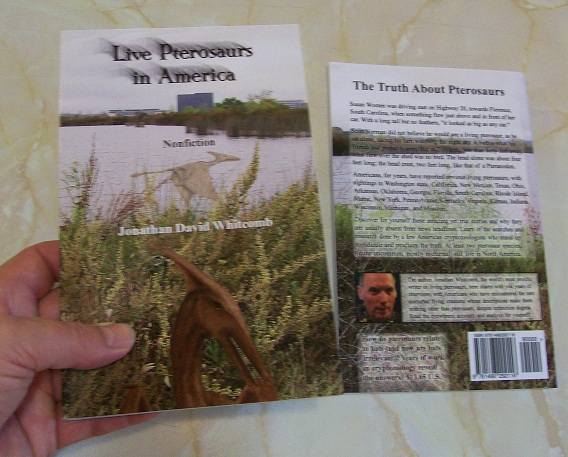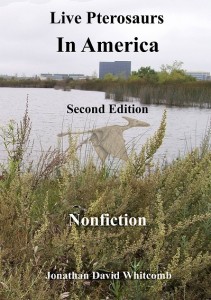I understand that not all sightings of apparently strange flying creatures must be modern living pterosaurs; I understand how eyewitnesses can misidentify something briefly flying by in the dark; I understand the possibility of fear influencing a person’s interpretation of an experience. But I do not understand how a critic can fail to see the fallacy of avoiding eyewitness-report details: More than once I’ve noticed a critic will invent an eyewitness scenario and appear to assume that the reported sightings of apparent pterosaurs fit into the critic’s fabricated outline. How dogmatic are some advocates of universal extinction of pterosaurs! When several characteristics of a description suggest a living pterosaur more than anything else, why insist that the strange flying creature must have been something non-strange? And why ignore the most credible eyewitnesses who have most clearly seen what was most obviously a modern living pterosaur?
“Bulverism” C. S. Lewis labeled the slick ploy of avoiding reasoning on a subject by pointing out the reason ones opponent is so silly. Do some criticisms of living-pterosaur investigations qualify as bulverism? I believe so. The case I here present may be a mild case of bulverism, but the ramifications, for logical or foolish conclusions, appear significant.
The paleontologist Glen Kuban, on his web site, makes some good points about the weaknesses in the 1856 railway tunnel “pterodactyl” story from Europe (paragraphs six through twelve on his site); I agree that the story appears to be some kind of hoax. But why take seven paragraphs to disprove that 1856 story, then ignore the many credible eyewitness accounts from the past seven decades? He demonstrates a weakness in the judgment of Carl Baugh, one of the early investigators of reports of living pterosaurs and then ignores critical details of investigations by Baugh’s associates who have long ago taken over where Baugh left off, improving the quality of the investigations.
If those seven paragraphs were all that Kuban had written, then bulverism would not apply; he would have made his point about that questionable 1856 story and any mention I would make about his motivations would have made me guilty of bulverism. But he wrote much more, appearantly doing all he could to discredit all living-pterosaur investigations.
I agree with Kuban that the 1856 story should not be used as if evidence for living pterosaurs (indeed that story gives little if any evidence for any strange flying creatures). But that old story should also not be used as if evidence that recent sightings are just as questionable. Using explosives to blast away rock to create a tunnel—that sometimes throws rocks into the air; but that is not evidence that meteors falling from outer space are fictional. It matters not how many tunnels are created by however many explosions, and it matters not how many old stories of living pterosaurs are questionable. Twentieth-century (and recent) sightings, by eyewitnesses like Duane Hodgkinson and Brian Hennessy—those deserve attention, Mr. Kuban.
He acknowledged that I had interviewed local natives of New Guinea. But he emphasized the crudeness of the sketches that one of the eyewitnesses and I had drawn. Why, Mr. Kuban, did you ignore a seven-meter-long tail? What need have we of a professional artist? I am not offended at his point that I am not a realistic artist; I am shocked that he would either carelessly miss critical points or purposefully leave them out of his writings.
Kuban wrote about thirty-one paragraphs to disparage the c0ncept of modern living pterosaurs. His web site is copyright-labeled “2004-2007,” so why did he write nothing about the 2006 expedition of Paul Nation? That explorer’s name is never mentioned, even though Paul went on more living-pterosaur expeditions in Papua New Guinea than any other American cryptozoologist. I suspect that Kuban has no desire to acknowledge that the two lights videotaped by Paul were later analyzed by a physicist and found to be anything but ordinary: solid support for the concept of a large unclassified bioluminescent flying creature.
Kuban’s thirty-one paragraphs say nothing about the American World War II veteran Duane Hodgkinson. How many web pages are written about that 1944 sighting! Could it be that this man’s account is too detailed and too credible? Nothing obstructed Hodgkinson’s view and the strange flying creature was only about a hundred feet away with it took off into the air and flew off, then flew back over that jungle clearing in New Guinea; the two soldiers had a second look and Hodgkinson was clear about the long tail: “at least ten or fifteen feet” long.
One of Kuban’s thirty-one paragraphs mentions a possible explanation of sighting reports: “It’s likely that at least some southern hemisphere sightings of “pterosaurs” are explained by fruit bats.” It also says that those bats, when “seen in silhouette (which would be the case at night) can present a pterosaur-like profile, especially to nonscientific observers.” But Hodgkinson’s sighting was in the middle of the day. In addition, how can anyone explain how a bat-tail about an inch long could appear in clear daylight to be “at least ten or fifteen feet” long. It seems that Kuban is far too intent on dismissing the general concept of modern living pterosuars, for he ignores the reports that would make his interpretation appear ludicrous.
Kuban’s thirty-one paragraphs say nothing about the Perth, Australia, sighting of 1997. How deeply has he researched eyewitness reports? The Australian couple have been interviewed and their accounts published online and in a book. Was Kuban aware, when he referred to “nonscientific observers” that the man in Perth, the man who described a flying creature with a wingspan of 30-50 feet, was a scientist?
Kuban’s thirty-one paragraphs say nothing about the Bougainville (Papua New Guinea) sighting of 1971. He wrote nothing about Brian Hennessy, although the Australian’s interview has been published in many web pages and in a book. Would Kuban consider Hennessy to be a “nonscientific observer?” His sighting was analyzed in a scientific paper published in a scientific peer-reviewed journal. Would Kuban consider Hennessy to be crazy for reporting an obvious “prehistoric” flying creature? That would indeed by unwise, for Mr. Hennessy is himself a professional psychologist.
Kuban’s thirty-one paragraphs give no details of what Gideon Koro and his friends saw flying over a lake one day. Kuban does mention my interview with Gideon, he just gives no details about what Gideon saw. Could this neglect relate to how difficult it would be to suggest a commonplace interpretation? Think about this. How could seven native boys (the older ones perhaps in their mid teens) have seen a flying fox fruit bat, flying over a lake, and then run home in terror, because they mistook it for a ropen that had a tail “seven meters” long? Please! How natives love to eat fruit bats! But how those boys would hate to be eaten by a ropen! And think about this: How difficult it is for a knowledgable, intelligent person to imagine seven teenaged boys running away, in terror, from their favorite dinner!
Why do I write about bulverism, when I am criticizing the writings of one who has pointed out apparently-real weaknesses in some reports that support modern living pterosaurs? It may be only a mild case of bulverism, for Kuban says, in paragraph three, that “most advocates of living pterosaurs are strict creationists or cryptozoologists.” He then points out a weakness in one of the writings of one of those creationists, implying that all living-pterosaur investigations are flawed. But why, Mr. Kuban, have you so strongly emphasized the questionable evidences and ignored the many compelling eyewitness testimonies? You may have given your readers the impression that no living-pterosaur investigator should be taken seriously. If that is what you intended, Mr. Kuban, then you have been guilty of bulverism.
_____________________________________________________________________
Live Pterosaurs in America, by Jonathan David Whitcomb, is a nonfiction book in the true genre of cryptozoology. The Christian beliefs of most of the living-pterosaur investigators are not hidden, neither are they trumpeted, but acknowledged in the appendix, let readers believe as they will.
Please support living-pterosaur investigations by purchasing this book about amazing eyewitness accounts of pterosaurs in many parts of the United States over many years. See Live Pterosaurs in America. (third edition — yes, this is NON-fiction)
From the Appendix of the third edition:
What would be the ideal documentary on living pterosaurs? One of two directions: searching for the truth in eyewitness testimonies or searching diligently for the creatures themselves. The “Flying Monsters” episode of MonsterQuest did neither, stumbling by stepping on the edge separating one stair from another.
_____________________________________________________________________
Flying creatures resembling pterosaurs




